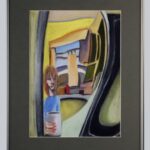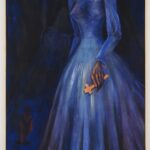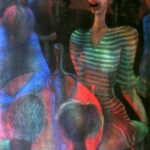
Zavišaitė Akvilė
Akvilė Zavišaitė was born on November 28, 1962 in Vilnius, to an architect and journalist.
She knew from an early age that she would be an artist. She drew and painted from the age of three. First, dogs, then horses, or rather, galloping horses, although she would sometimes depict one sitting, like a dog. Horses were her second love (after dogs), she had even started attending riding lessons, but at the encouragement of her mother, she switched to swimming.
As an adult, she became fascinated with expressive dance and, although she had never learned to dance anywhere, she amazed those around her with the grace of her movements and flexibility of her body. She played the guitar quite well, and for a while she also learned to play the flute.
Before Akvilė started attending primary school, her parents divorced: her father, an avid sailor, stayed to live in Nida, where the family spent two years together, and her mother returned to Vilnius. Akvilė studied in Vilnius, spending her summers with her father.
While in her last years at Vilnius Secondary School No. 44, she began preparing for the exams to the State Institute of Arts (now the Academy of Arts), attending private drawing lessons with the artist Drėgvas.
However, she was not allowed to take the entrance exams at the Vilnius Institute of Arts – during the so-called mandate commission, it turned out that Akvilė was not a Komsomol member. Neither Akvilė’s father, Algis Zaviša, a graduate of the same higher education institution, nor the then famous writer Juozas Baltušis, her grandfather, did any “blato”, as patronage was called at the time.
Never forgetting her love for animals, Akvilė decided to go to Kaunas to study veterinary medicine or… get a job as a night bartender or dancer, and try to enter the art school the following year. However, her family dissuaded her from doing so, so she stayed in Vilnius and enrolled in the Pedagogical Institute (now the Pedagogical University) to study English.
After completing her second year of practice at Vilnius Salomėja Nėris Secondary School, where she had also studied briefly, Akvilė received very good feedback from teachers and encouragement to become a teacher after graduating. Akvilė decided to become a drawing teacher.
However, her pedagogical studies had to be interrupted when, in 1983, she received permission to leave for permanent residence in Australia, where Akvilė’s mother had already settled.
After her mother left, Akvilė was cared for by her mother’s sister Violeta and actress and poet Elena Petrauskienė (Žalinkevičaitė). Life in the home of this popular Vilnius personality of that time, called by many simply Mrs., and conversations with her later inspired Aquilė’s painting “The Lady of the Crosses”.
That same year, she enrolled at Newcastle College of Advanced Education School of Visual and Performing Arts, where she chose painting, drawing, and ceramics. She also studied French separately.
In 1987, she graduated with a Bachelor of Arts degree and a diploma as an artist.
That same year, having arrived in the United States (where her mother lived and worked at the time), Aquilė did not stay here long, although she had received an internship at the New York Institute of Art and Film Arts.
Returning to Australia, she enrolled in graduate school at the Hunter Institute of Higher Education, wrote and defended her dissertation “My Life and My Art” (see “Aquilė. Paintings, Letters, Memories”). For this she was awarded a graduate diploma.
In 1988 Akvilė went to Lithuania. In February-March 1989, a personal exhibition of her paintings was held at the Vilnius Art Museum.
In October of the same year, the paintings that returned from Lithuania to Australia were exhibited in a personal exhibition at the Newcastle Burns-Kaldy Gallery and in the two-artist exhibition “Gallery de Maurianne” in Sydney.
Akvilė Zavišaitė has participated in exhibitions since 1984 (in total, her paintings have been exhibited in fourteen collective and personal exhibitions).
Her works (mostly signed only by name) have been exhibited in Australia, the United States of America and Lithuania.
Three retrospective exhibitions of Akvilė’s works were held after her death at the Čiurlionis Gallery, Chicago, USA, 1991; Vilnius Artists’ Palace, 1997; in the gallery “Akademija” 2006).
The last exhibition featured the Lithuanian television documentary “Akvilė”; it also showcased embroidered cloths in memory of Akvilė by friends and relatives, such as those made for AIDS victims in Australia and the USA. The two-week exhibition was visited by 1,470 people.
Akvilė Zavišaitė died in Sydney on June 2, 1991. She had been battling the deadly virus in her blood for three years. Having shared only half of that tragic time with her relatives, she consoled and encouraged them herself, especially in the last months of her life.
The artist left behind about 50 large canvases and drawings, numerous sketches, postcards, and ceramic works. The works on canvas were done in a special pastel technique, creating an image from small dashes of various colors.
Akvilė’s first major work was the triptych “Bellevue” dancers (during her studies, she herself danced on the stage of that bar).
In general, her works are characterized by elongated figures of young women – bar dancers, ballerinas – half-naked or dressed in extraordinary costumes, a number of portraits and self-portraits, and there are also
symbols, zodiac signs. In some paintings, beautiful, mysterious women pose against a seemingly eerie background, surrounded by knives, syringes, snakes, cobwebs, and torn hearts rolling on the floor. However, there is no shortage of humor, eerie and funny large-format group portraits of plush toys (“Night Tea”, “On the Shelf”).
“I think that Aquilė’s works awaken something very intimate, spiritual in everyone who sees them, and the elements of satire and caricature may even be frightening.
Aquilė was a true artist. A Lithuanian sorceress. She enriched many people who were lucky enough to know her over the years.
Aquilė can also be boldly called the embodiment of freedom and human dignity. She was a true citizen of the world. God bless her.”
This is what her former teacher, Newcastle University lecturer Garry Jones, said about Aquila. Whether he is right or not, we leave to the visitors of this site to decide.
EXHIBITIONS:
1984 LITHUANIAN ART AND FOLK ART EXHIBITION
Canberra, Australia
1986 LITHUANIAN ART AND FOLK ART EXHIBITION
Adelaide, Australia
1986 GROUP EXHIBITION
Spears Point Gallery, Newcastle, Australia
1986 GROUP EXHIBITION
Lake Macquarie Gallery, Lake Macquarie, Australia
1988 LITHUANIAN DIASPORA ART EXHIBITION
Vilnius Exhibition Hall (youngest participant)
1989 ART‘89
Chicago-New York-Cleveland-Washington, USA
1989 SOLO EXHIBITION
Vilnius Art Museum, Lithuania
1989 SOLO EXHIBITION
Burns-Kaldy Gallery, Newcastle, Australia
1990 TWO-ARTIST EXHIBITION
Gallery de Maurianne, Sydney, Australia
1990 RELIGION IN LITHUANIAN ART
Čiurlionis Gallery, Chicago, USA
1991 LITHUANIAN ART REVIEW EXHIBITION ART‘91 Lithuanian World Center Art Museum, Lemont, USA
1991 RETROSPECTIVE PERSONAL EXHIBITION Čiurlionis Gallery, Chicago, USA
1997 RETROSPECTIVE PERSONAL EXHIBITION
Vilnius Artists’ Palace, Lithuania
2006 RETROSPECTIVE PERSONAL EXHIBITION
Akademija Gallery, Vilnius, Lithuania




